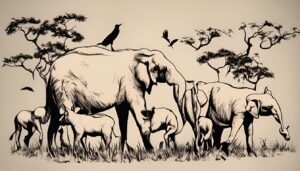Endangered Species Facts
The natural world is home to an incredible diversity of species, each playing a vital role in maintaining the balance of ecosystems. However, many species are facing the threat of extinction due to human activities, climate change, and habitat destruction. In this blog, we will explore some fascinating and important facts about endangered species, shedding light on their plight and what we can do to help protect them.
 What Does “Endangered” Mean?
What Does “Endangered” Mean? An endangered species is one that is at a high risk of extinction in the wild. The International Union for Conservation of Nature (IUCN) maintains the Red List, which classifies species based on their conservation status. Categories include:
- Least Concern
- Near Threatened
- Vulnerable
- Endangered
- Critically Endangered
- Extinct in the Wild
- Extinct
Causes of Endangerment- Habitat Destruction
- Deforestation, urbanization, and agriculture are leading causes of habitat loss, leaving many species without a place to live and thrive.
- Climate Change
- Changes in temperature and weather patterns can disrupt habitats and food sources, making survival difficult for many species.
- Poaching and Illegal Trade
- The illegal wildlife trade, driven by demand for exotic pets, traditional medicine, and luxury goods, has pushed many species to the brink of extinction.
- Pollution
- Pollution of air, water, and soil can have devastating effects on wildlife, causing illness, reproductive failure, and death.
Top 10 Endangered Species Facts 1. Amur Leopard- Status: Critically Endangered
- Population: Fewer than 100 individuals
- Habitat: Temperate forests of the Russian Far East and northeastern China
- Threats: Poaching, habitat destruction, and inbreeding
2. Sumatran Orangutan- Status: Critically Endangered
- Population: Approximately 14,000 individuals
- Habitat: Rainforests of Sumatra, Indonesia
- Threats: Deforestation, palm oil plantations, and illegal hunting
3. Vaquita- Status: Critically Endangered
- Population: Fewer than 20 individuals
- Habitat: Northern part of the Gulf of California, Mexico
- Threats: Bycatch in illegal gillnets used for fishing
4. Javan Rhino- Status: Critically Endangered
- Population: Approximately 74 individuals
- Habitat: Ujung Kulon National Park, Java, Indonesia
- Threats: Habitat loss, poaching, and natural disasters
5. Mountain Gorilla- Status: Endangered
- Population: Approximately 1,063 individuals
- Habitat: Mountainous regions of Rwanda, Uganda, and the Democratic Republic of Congo
- Threats: Poaching, habitat destruction, and human-wildlife conflict
6. Hawksbill Turtle- Status: Critically Endangered
- Population: Unknown, but declining
- Habitat: Tropical coral reefs
- Threats: Illegal trade of shells, loss of nesting sites, and marine pollution
7. Snow Leopard- Status: Vulnerable
- Population: Between 4,000 and 6,500 individuals
- Habitat: Mountain ranges of Central and South Asia
- Threats: Poaching, habitat loss, and human-wildlife conflict
8. Blue Whale- Status: Endangered
- Population: Between 10,000 and 25,000 individuals
- Habitat: All the world’s oceans
- Threats: Ship strikes, entanglement in fishing gear, and climate change
9. Sumatran Elephant- Status: Critically Endangered
- Population: Approximately 2,400 to 2,800 individuals
- Habitat: Lowland forests of Sumatra, Indonesia
- Threats: Habitat loss, human-wildlife conflict, and poaching
10. Saola- Status: Critically Endangered
- Population: Unknown, but very rare
- Habitat: Annamite Range of Laos and Vietnam
- Threats: Habitat loss, poaching, and limited range
How Can We Help?- Support Conservation Organizations
- Donate to or volunteer with organizations working to protect endangered species and their habitats.
- Reduce, Reuse, Recycle
- Minimize waste and reduce your carbon footprint to help combat climate change and habitat destruction.
- Avoid Wildlife Products
- Do not buy products made from endangered species, such as ivory, turtle shells, or exotic pets.
- Educate and Advocate
- Raise awareness about endangered species and advocate for stronger conservation policies.
- Responsible Tourism
- Support eco-friendly tourism practices that prioritize the well-being of wildlife and their habitats.
Conclusion Endangered species are a critical part of our planet’s biodiversity, and their loss would have far-reaching consequences for ecosystems and human well-being. By understanding the causes of endangerment and taking action to protect these vulnerable species, we can help ensure a future where wildlife thrives. Every effort counts, and together, we can make a difference.
animal  What Does “Endangered” Mean? An endangered species is one that is at a high risk of extinction in the wild. The International Union for Conservation of Nature (IUCN) maintains the Red List, which classifies species based on their conservation status. Categories include:
What Does “Endangered” Mean? An endangered species is one that is at a high risk of extinction in the wild. The International Union for Conservation of Nature (IUCN) maintains the Red List, which classifies species based on their conservation status. Categories include: